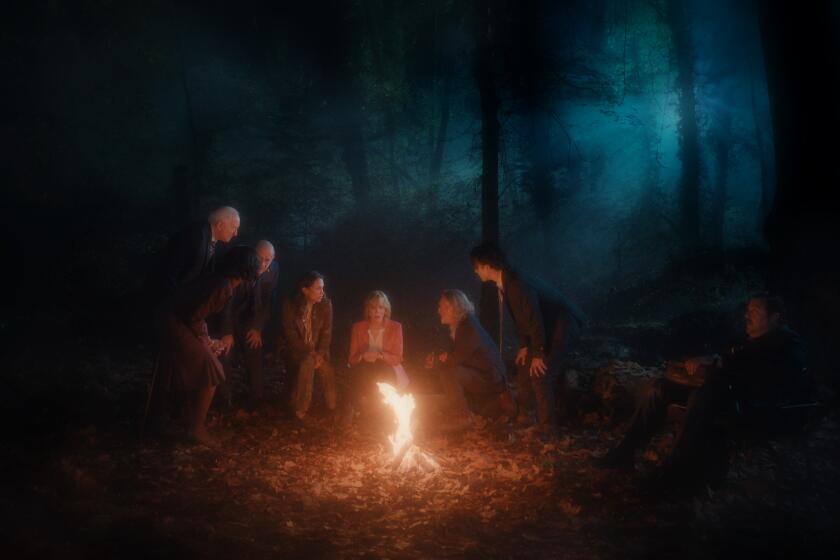A Voyage to the Indies : Movies: A Santa Monica movie theater and the American Film Institute join forces to showcase independent filmmakers.
Today we send up a rocket for the independents among us, those Americans who do their own things as they swim upstream listening to the sounds of different drummers.
The subtext is making it sometimes in an often brutal commercial world.
Gregg Araki makes movies and is called by some the king of L.A. guerrilla filmmakers. He turns out feature-length films that cost under $5,000 for audiences that just might fill up a telephone booth.
Robert Laemmle is a theater owner carrying on a family tradition in most of his movie houses of presenting off-road, non-Hollywood art films and foreign films.
Ken Wlaschin of the American Film Institute works at finding screens for generally non-mainstream filmmakers.
Early this year they and a few others came together in a unique attempt to put the noncommercial works of independent filmmakers into a commercial arena, in this case, Laemmle’s Monica 4-Plex on 2nd Street in Santa Monica.
It started as an experiment last April called the AFI USA Independent Showcase and has now begun to take on a life of its own, surviving its first two months and now scheduled to continue through the summer at least.
Each filmmaker gets a full week’s booking--25 showings in seven days.
Each filmmaker gets advertised and promoted through the theater’s regular efforts and the AFI’s extensive membership mailings.
Each filmmaker faces the sometimes testing experience of being reviewed by mainstream critics.
And wonder of wonders, each filmmaker may get a return on his investment if the box-office take is big enough.
The showcase may be setting a precedent, providing a form of cinematic coexistence during an era of $80-million-plus “Terminators” and $50-million “Robin Hoods.”
It was the spread of Hollywood’s enterprises that caused Laemmle a couple of years ago to go to a nearby mountain top to consider the future of his 20-year-old Santa Monica theater, which started life as a twin-plex. In the interim, Westwood began to attract most of Hollywood’s films, then Century City started taking over some of the Westside action and then there was talk of new movie complexes as Santa Monica redeveloped 3rd Street.
Laemmle has four screens to fill and a lot of heavy Hollywood action just around the corner. So he turned to AFI and said give me your tempest-tossed just when Wlaschin and others were looking for a way to display the often-unseen works of American independents who were capturing film festival prizes but rarely got shown because of personal subject matter, avant-garde plot structure and because their work was usually shot on 16-millimeter film.
Then, fortunately for all parties, AFI got some necessary financial help--$60,000 from the MacArthur Foundation.
AFI got its showcase.
Laemmle got one-quarter of his Santa Monica screens booked.
The filmmakers got a chance to be seen and possibly earn some money.
A sliding scale based on the box office determines how much of the $6.50 ticket price, if anything, gets to the independent.
The first four weeks were predictably rocky. Laemmle hoped to average a break-even 1,000 tickets a week for the 220-seat room. Some of the films leaned heavily toward the experimental and in Laemmle’s words, “L.A.’s not an experimental film town.”
But business has picked up and films now scheduled are more in traditional narrative form, such as “American Taboo,” which starts its seven-day run Friday (see review at right). The 1983, 94-minute film by Steve Lustgarten was made for $20,000 and is a love-lust story about a photographer and a teen-age girl.
A similar theme runs through Alexander Payne’s “The Passion of Martin,” which is scheduled for July 12-18.
All the films are low budget. Most follow feature formats. Most were shot on location. But they are all booked into the same house that currently is showing “Cyrano de Bergerac” with Gerard Depardieu, John Cassavetes’ “Killing of a Chinese Bookie” and Henry Jaglom’s “Eating.”
This effort to give independents a chance to be heard and to be seen in traditional commercial venues has its counterparts elsewhere.
The Music Center’s Center Theatre Group is heading toward its fourth year of “Taper Lab 91: New Work Festival” at the Ford Theatre where new plays are stage read in a professional setting. Bill Cain’s “Stand-Up Tragedy” and George C. Wolfe’s “Jelly’s Last Jam” were first presented at the Lab.
The Los Angeles Theatre Center hopes next spring to return with its “Big Weekend,” the stage reading of new plays before a paying audience at its Spring Street complex.
The Pasadena Playhouse offers a “Discovery Series” of reading by unproduced writers.
And under its “Green Umbrella” series the Los Angeles Philharmonic presents new musical works offered in the professional environment of the Japan America Theatre.
Somehow, whether it’s at a 4-plex in Santa Monica or the Ford Theatre in Hollywood, independents occasionally find an audience.
Not always so easily though. So we’ll send up another rocket because somehow the independents do it their way, paddling their own canoes, thinking free and unfettered.
More to Read
Only good movies
Get the Indie Focus newsletter, Mark Olsen's weekly guide to the world of cinema.
You may occasionally receive promotional content from the Los Angeles Times.










